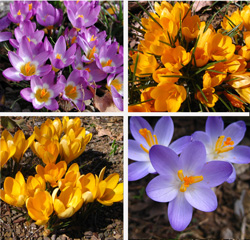Resource Library
Plant of the Week: Crocus
The University of Arkansas System Division of Agriculture does not promote, support or recommend plants featured in "Plant of the Week." Please consult your local Extension office for plants suitable for your region.
Crocus

Groundhog Day of 2011 followed what some meteorologists are calling the "storm of the (still young) century" that dumped snow and ice across much of the Midwest and New England states. The 6 inches blanketing my garden are covering the few early flowers that were being tricked into believing spring was afoot. The crocus species I have been adding to my rock garden were the most advanced, and a few were even in bloom when the snow hit. I have no concern for the crocus, for blooming early is their nature.
Over 80 species of crocus have been described to date, but only about 30 are currently being grown in gardens. Crocuses are native to a wide swath of Southern and Central Europe, the Middle East and Western China, where they usually are part of open, grassy pastures or knoll communities. They all form a small, flattened corm, which is replaced annually. From the corm emerge several flowers and grass-like leaves marked with a white stripe down the top side. Crocuses are a member of the Iris family.
Crocuses tend to be small, with most under 6 inches in height when in full bloom. Depending on the species, blooms are produced in late winter, early spring or in the fall. The 1-to-2 inch wide, funnel-shaped flowers are typically in shades of lavender, yellow, white or purple, often with contrasting color blotches or stripes.
The most commonly sold crocuses, the Dutch hybrids, are flamboyant plants with oversized blooms, leaves and corms, thanks to the efforts of bulb breeders. These robust hybrids have 24 chromosomes in each cell, whereas the wild species usually have eight. The species crocus and their cultivars tend to be more diminutive and delicate plants than the oversexed, sterile hybrids.
To date I have accumulated 25 selections of 15 different species. This is just scratching the surface of the group, for at least 800 kinds are available from serious collectors. Crocus collecting is an interesting adjunct to rock gardening, for the spring blooming species usually flower early and finish about the time more sensible plants send forth their first blossoms. And crocuses are small, so they easily nestle in amongst the other plants. In my north-facing rock garden, Crocus flavus, C. sieberi, and C. laevigatus are the first to bloom in mid-to-late February. About two weeks later, C. chrysantus, C. tommasinanus, C. minimus and C. vernus sequence into bloom as the earlier species give way to leaves.
Crocuses are easy to grow in any reasonably good garden soil with normal drainage. Corms are planted about 2 inches deep in the fall. Plant six to 12 corms together in one location to create a showy clump and a more concentrated display. If well-sited and the species is happy in its new home, the clump should become permanent and persist for years with little additional care. Divide the clump only when new corms are needed, or when it ceases to flower due to overcrowding. Crocus corms can be planted beneath trailing plants, such as creeping phlox or dianthus, thus providing an easy way to "double crop" the space. It is not uncommon for crocus species to set viable seeds and begin to appear in unexpected places around the rock garden.
By: Gerald Klingaman, retired
Retired Extension Horticulturist - Ornamentals
Extension News - February 11, 2011
The University of Arkansas System Division of Agriculture does not maintain lists of retail outlets where these plants can be purchased. Please check your local nursery or other retail outlets to ask about the availability of these plants for your growing area.